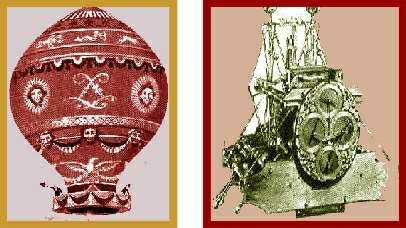|
Improvements were naturally made in the matter for transport and communication for carrying merchandise from one place to another. The inland navigation was developed and the steamboat came into use. In 1815, Stephenson built the first locomotive and in 1830 the first passenger railway was inaugurated from Liverpool to Manchester. Great improvements were made in mining coal and iron. Another significant development was the use of steam power. Before the Industrial Revolution, the difficulty was felt in finding a good source of power. The wind or waterpower was neither sufficient nor always available. The problem was solved by the invention of steam power. Newcomen, Smeaton, and others gradually developed the use of the steam engine which was later improved by James Watt (1785). By the end of the century steam engines were used for driving practically all machines.

An Air Balloon A Marine Chronometer
Exhibit 3.2
Various Inventions
The invention of telegraph and telephone, the laying of submarine
cables, the wireless development, the postal system etc. all these
combined to bring closer the distant places of the world. England
enjoyed the favorable balance of trade. As she was not highly populated,
she could not find enough hands to work. Due to this necessity she
led the way to the machine age.
|
Index
3.0 -
Introduction
3.1 The Seven Years' War
3.2 Catherine the Great
3.3 The Industrial Revolution
3.4 The French Revolution
3.5 France as a Republic (1795 - 1799)
3.6 Napolean Bonaparte
3.7 Points to Remember
Chapter 4
|